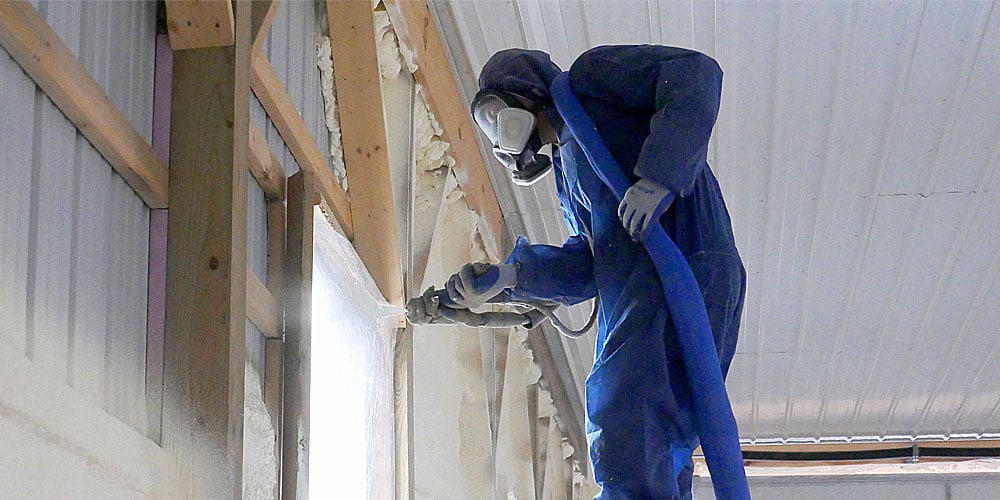Installing Spray Foam Insulation in Metal Buildings When It’s Cold


As temperatures drop, many homeowners and contractors ponder whether installing spray foam insulation in metal buildings, such as pole barns, during colder months is feasible.
The short answer is yes, but it comes with unique challenges and considerations, especially when dealing with steel siding and roofing.
This article delves into the intricacies of spray foam insulation application in cold weather, offering insights to ensure effective insulation despite the temperature dips.
Best Time for Insulation: Seasonal Considerations
The optimal time for insulating a pole barn or metal building is a subject of much debate.
Generally, spring is preferred due to its mild temperatures. However, waiting until spring may not always be feasible or desirable.
Winter installations are possible but require careful planning and execution. The key is understanding the material behavior and the environmental impacts on the installation process.
Challenges of Spray Foam Insulation in Cold Weather
There are several issues that can arise when adding spray foam insulation to a metal building in cold weather.
From the risk of condensation to an increased cost, let’s dive right into some of the challenges of spray foam in cold weather.
Reduced Expansion and Yield
In colder weather conditions, closed cell spray foam, which is recognized for its minimal expansion, can yield even less than anticipated.
As a result, this reduced expansion may lead to increased usage of materials and potentially result in higher costs.
Considering these factors is important when planning and executing insulation projects during chilly temperatures.
Condensation Risks
When hot spray foam comes into contact with a cold metal surface, the stark temperature difference creates the perfect conditions for condensation to form.
If left unaddressed, this moisture can impede the foam's adhesion capabilities, resulting in delamination. During delamination, the insulation fails to adhere properly, compromising its overall effectiveness in providing thermal insulation and moisture resistance.
It's important to recognize and mitigate this potential issue to ensure the long-term performance and durability of the insulation system.
Mitigating the Challenges
Despite these hurdles, winter installations aren’t off the table.
Here are some strategies to mitigate the challenges.
Heating the Building
Properly heating the building without adding humidity is crucial.
This helps in maintaining the metal surface at a temperature conducive to foam application.
It’s important to note that if the heater you plan to use is gas or propane, it can release more moisture into the air. A diesel fuel heater is a much better fit in this instance.
Using Flash Coating Techniques
Application techniques, such as flash coating, can be effectively utilized to manage the behavior of the foam in cold conditions.
This method optimizes the foam's response and performance, ensuring its stability and functionality even in low-temperature environments.
Client Communication
It is important to thoroughly discuss and elaborate on the potential complexities and additional costs associated with a winter installation.
By providing a comprehensive understanding of the implications, both the homeowner and insulation contractor are fully informed and prepared for any challenges that may arise due to the season's conditions.
Open and transparent communication will help establish realistic expectations and foster a strong client relationship based on trust and mutual understanding.
Can You Spray Foam in the Winter?
Yes, with the right techniques and precautions, spray foam insulation can be successfully installed in metal buildings during winter.
However, weighing the benefits against the potential for increased costs and time is crucial due to the extra preparation required.
Temperature Guidelines for Spray Foam Insulation
Since there is no one-size-fits-all temperature guideline, it’s essential to follow the specific guidelines provided by the foam manufacturer for the best results.
Some spray foam manufacturers recommend not adding closed cell at all when it’s cold. The concern is that once the temperature gets below a certain threshold, the substrate will be cold, and this runs the risk of creating condensation.
The manufacturers have to state this because they cannot know the insulation contractor’s level of experience. An experienced contractor will have the knowledge, skill, and understanding that the project will take longer, and they will need to use more closed cell spray foam to create the needed air seal.
Weighing Your Spray Foam in Cold Weather Options
Insulating a metal building in winter is a complex undertaking that demands a nuanced approach.
If you're considering this for your pole barn or metal structure, weigh the pros and cons carefully. In many cases, waiting for warmer weather might be more cost-effective and less challenging.
If you're unsure about the best approach for your project, our Learning Center is here to help.
With expert advice and comprehensive guides, we can assist you in making informed decisions about spray foam insulation, regardless of the season.
Related Articles
What is the Difference Between RetroFoam Injection Foam and Spray Foam Insulation?
About Eric Garcia
Eric brings his knowledge and training in building science, training in spray and injection foams from the manufacturers, more than eight years installing foam insulation, as well as selling and managing in the foam insulation industry. He is also BPI and Dale Carnegie certified and has taken several building science courses, including air sealing and building envelope. Eric is the Professor of Foam on our educational YouTube series Foam University. Even when Eric is off he is usually still “working” or thinking about work, but when he can get away he enjoys camping, hiking, hunting, and woodworking.


